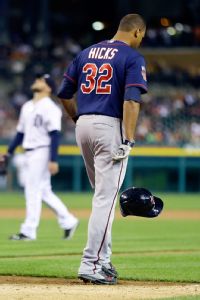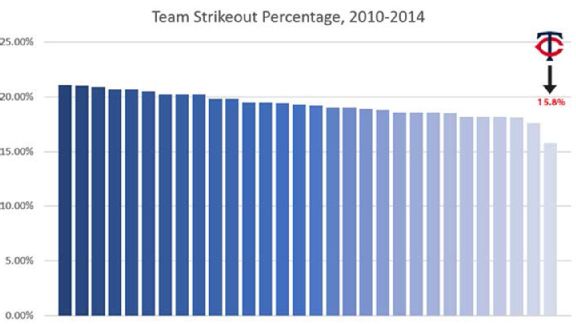Once again, major league baseball players are striking out at previously unseen levels, with 20.5 percent of plate appearances ending in a whiff, which would set a record for the ninth year in a row. And once again, the
Minnesota Twins' pitching staff is doing its best to go against that trend.
Twins pitchers currently sit in last place in strikeout percentage; their 14.9 percent whiff rate is a full 1.6 percent behind the No. 29 White Sox. (If you prefer K/9, their 5.85 rate is also in last place, well below the league average of 7.85.) Not that this is new. The Twins had the majors' lowest strikeout percentage rates in 2011, '12 and '13 as well.
Perhaps unsurprisingly, the Twins' cumulative pitching strikeout percentage dating to 2010 pulls up the rear by a considerable amount:
Mike PetrielloTwins pitchers have far and away the lowest strikeout rate in MLB since 2010.
This is, of course, embedded in the Twins' DNA. It's who they are, endlessly giving innings to low-upside and low-strikeout pitchers like
Brian Duensing,
Nick Blackburn,
Carl Pavano,
Scott Diamond and
Kevin Correia, and it's part of the reason they're 72 games under .500 in that span.
But this year, they're treading into some particularly dangerous waters, because the roster they've assembled is the worst-case scenario: They have a staff full of pitchers who allow balls to be put in play in front of a defense that isn't particularly effective at turning those balls into outs.
An offensive defense
Defense can be measured a few ways, though none of them are without their issues over a small sample size. But when they're all generally saying the same thing -- that the Twins' defense is quite poor -- it's difficult to toss that data away. Defensive runs saved, for example, has the Twins at minus-23, just barely ahead of the last-place Indians. (The Cardinals currently lead the majors with 29 DRS.) UZR/150 has the Twins at minus-4.8, 23rd best. They are middle of the pack in errors, if you care about that, but they might be worse if they could get to more balls; they're No. 26 in range runs, which is determined by FanGraphs "by how the fielder is able to get to balls hit in his vicinity."
It goes beyond just the fact that the overall defense isn't great, because the Twins have managed to build a staff that specifically caters to the weakness of their fielders. Right now, Twins pitchers are allowing fly balls at a 38.4 percent rate, tied with the Angels for the most in baseball. That's not necessarily a bad thing; fly balls that don't leave the park -- and the 8.0 percent HR/FB rate Minnesota has is solid enough -- generally turn into outs at a higher rate than grounders do.
But despite allowing the same rate of fly balls, the outcomes for the Twins and Angels have been very different. Although the Angels walk more batters and allow slightly more home runs, they have allowed 28 fewer runs than the Twins while playing one more game. One reason is they have pitchers who can actually miss bats; their strikeout percentage is fourth best in baseball and a full 7.6 percent higher than that of the Twins. They also have something nearly as important: an outfield that actually turns those fly balls into outs.
Outfield shuffle
Looking only at outfielders, the Angels have the best DRS mark in baseball, helped by plus fielders like
Mike Trout,
J.B. Shuck and
Collin Cowgill. The Twins, meanwhile, are in dead last, with a minus-18 mark that represents a full 38-run difference from the Angels.
[+] Enlarge

AP Photo/Carlos OsorioAaron Hicks (career .588 OPS) has failed to establish himself.
That's partly due to injury -- infielders
Eduardo Escobar,
Eduardo Nunez and
Danny Santana have each started in the outfield in the past week -- but mostly due to the fact that the outfielders the Twins have put together just aren't quality defenders.
Chris Colabello, in the early conversation for worst defensive outfielder in baseball, was primarily a first baseman in the minors.
Jason Kubel was a below-average outfielder in his first stint in Minnesota. Now, as he prepares to turn 32 next week, he's now a disaster with the glove yet has received more defensive playing time than any other Twins outfielder.
Minnesota fans can rightfully point to the fact that the outfielders who were expected to be assets in the field have failed to stick in the lineup for various reasons.
Aaron Hicks came to the big leagues with a good defensive reputation, but has failed to show that: He has hit only .185/.270/.315 in parts of two seasons and recently missed time with a concussion.
Sam Fuldjoined the team in late April and provided value in center, but he also has not hit much and has had a concussion.
Josh Willingham, never much of an outfielder, hasn't played much this year because of a wrist injury, and he won't be expected to help much with the glove when he returns. The same goes for
Oswaldo Arcia, also out with a wrist injury, who is expected to receive significant playing time this year despite some horrendous defensive play in 2013 (minus-15 DRS in just 97 games).
A mess of their own making
While the injuries and Hicks' ineffectiveness have been unfortunate, the Twins put themselves in this position -- partly because they collected defensively challenged players like Kubel and played out-of-position first basemen like Colabello, and partly because of a spring decision that backfired terribly. Minnesota decided to keep 34-year-old
Jason Bartlett and use him as an outfielder, a position he'd never played before. (It was a decision made almost entirely because of his clubhouse presence, according to Ron Gardenhire.)
By keeping Bartlett, a shortstop they traded in 2007 and who didn't even play professional baseball in 2013, the Twins lost outfielder
Alex Presley -- a competent left fielder -- on waivers to Houston. When Bartlett retired in April, after just three games, zero hits and minus-2 DRS, the Twins were forced to cut loose outfielder
Darin Mastroianni because of a paperwork issue related to Bartlett's sudden departure. Mastroanni had 24 stolen bases in only 271 plate appearances with the team, along with average-at-worst defense. But by keeping Bartlett, the Twins received zero production and lost two decent outfielders, and now they're resorting to using inexperienced infielders in the outfield.
Teams can succeed without top-notch defense, as the
Detroit Tigers have shown. They can get by without huge strikeout numbers if they have a good defense, as the
Pittsburgh Pirates have the past two years. But there's almost no way they can live with both of those things combined. Until one is solved -- or both -- the Twins are doomed for another season without playoff baseball.




 why does
why does 




















